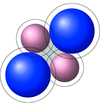issue contents
September 2015 issue

Cover illustration: The electrode reaction in the LiFePO4 cathode of the lithium ion battery is very inhomogeneous. The charge/discharge reaction takes place at some reaction channels. The vertically dispersive XAFS technique achieves the real time observation of the inhomogeneous electrode reaction on the basis of the oxidation state of the Fe species (see Katayama, Miyahara, Watanabe, Yamagishi, Yamashita, Kizaki, Sugawara and Inada, pages 1227-1232).
facility information
research papers
It is shown that dynamics on time scales shorter than the pulse duration of synchrotron sources can be studied by measuring the relative frequency of single and double photon events.
The glitch patterns of Si(111) double-crystal monochromators (DCMs) have been investigated, including their periods, azimuthal angle sensitivities and mirror symmetries. The optimal azimuthal orientation φ1,2 = [(2n+1)π]/6 (n = 0, ±1, ±2…) for Si(111) DCMs to achieve the least amount of glitches in the hard X-ray region has been suggested.
Influence of higher harmonics of the undulator in X-ray polarimetry and crystal monochromator design
Limiting factors in high-resolution X-ray polarimetry and monochromator performance due to Compton scattering are presented.
Open  access
access
 access
accessA 0.27 meV-bandwidth monochromator for 21.5 keV synchrotron radiation demonstrates exceptional stability using cryogenic stabilization and active feedback control.
A new optical layout for large infrared beamline opening angles is proposed which removes the source aberrations and provides intense and highly collimated IR beams.
Two cooling techniques to reduce thermal deformation in a water-cooled X-ray mirror, where the beam footprint is shorter than the mirror length, are proposed. The thermal deformation can be reduced by a factor of up to 45, compared with normal side cooling.
A new open-source Python-based library for data acquisition, device manipulation and scan routines is presented.
Open  access
access
 access
accessThe abilities on dead-time correction of a real-time digital pulse processing (DPP) system for high-rate high-resolution radiation measurements are presented. The DPP system, through a fast and slow analysis of the output waveform from radiation detectors, is able to perform an accurate estimation of the true input counting rate (ICR), a fine pulse height (energy) and shape (peaking time) analysis even at high ICRs.
An X-ray detector capable of millimeter-scale two-dimensional spatial resolution and 100 ps time resolution in a continuous high-rate data stream is described.
Description of the helium-3 fridge insert at beamline P09 at PETRA III and demonstration of its workability in a synchrotron X-ray beam at a third-generation synchrotron source for the purpose of X-ray diffraction and resonant X-ray magnetic scattering at sub-Kelvin temperatures in high magnetic fields.
The bi-metallic iron palladium exopolysaccharide (FePd-EPS) biomaterial, bio-generated for the first time by Klebsiella oxytoca strain BAS-10, is analysed by Fe and Pd K-edge XANES and EXAFS, micro-X-ray fluorescence, transmission electron microscopy and Fourier transform infra-red spectroscopy, and compared with mono-metallic Pd-EPS and Fe-EPS complexes.
A vertically dispersive X-ray absorption fine-structure measurement system was constructed for the sequential measurement of space-resolved XAFS data. The time and spatial resolutions of the instrument were estimated as 1 s and 100 µm. The system was used to analyze the reaction distribution and its spatial propagation for the LiFePO4 lithium ion battery during the charging process after the potential jump.
Using XAFS, the structure of Hg-based Ayurvedic drug, Rasasindura, is investigated with the objective of finding evidence towards its claimed non-toxicity. This study establishes that chemical form, rather than heavy-metal content, is the correct parameter for evaluating the toxicity in Ayurvedic drugs.
An updated discussion of the properties of parallel and perpendicular mean square relative displacement (MSRD) is made, based on recent experimental EXAFS results. The quasi-harmonic analysis of the parallel MSRD has allowed an evaluation of the bond Grüneisen parameter.
Muffin-tin potentials are used to examine contributions to EXAFS data from scattering geometries not represented in the cluster of atoms used to compute these potentials.
Phase contrast imaging of the hepatic portal system with O2 gas is reported.
Open  access
access
 access
accessThe formalism of iterative tomographic reconstruction with sparsity inducing penalty is extended to enable ring artifacts correction.
Phase-contrast X-ray imaging using a paper analyzer is a robust technique with a simple experimental set-up capable of reconstructing images with short single-exposure times. Here the choice of experimental parameters for fast, accurate quantitative phase retrieval is explored.
short communications
A compact multi-functional diagnostic tool for the commissioning of beamlines is presented. The instrument can consecutively measure energy resolution, flux and beam size.
Open  access
access
 access
accessA simple frequency domain technique for determining the time delay between laser pump and X-ray probe pulses achieves 1 ps resolution even for ∼100 ps synchrotron pulses, permitting improved pump–probe characterization of ultrafast processes.
This study reports on the design, fabrication and testing of a restraint device that holds an anaesthetized mouse in a vertical orientation for computed tomography imaging in a synchrotron X-ray imaging hutch.
beamlines
Open  access
access
 access
accessThe utilization of elliptical dipole radiation in a collimated plane-grating monochromator at BESSY II is described.
The microprobe system installed on the nanoprobe/XAFS beamline BL8C at the Pohang Light Source, South Korea, is described.
A photon beam-position monitor is upgraded into a spherical-grating monochromator beamline for the extreme ultraviolet to soft X-ray spectral regions.
computer programs
Open  access
access
 access
accessA computer program for simulating the amplification process in free-electron lasers and postprocessing the simulation results is presented.
letters to the editor
Free 

Free 

The Executive Board of KIT has decided to operate ANKA as a research facility rather than as a national and international user facility; a response to Braun's comments in the previous paper.


 journal menu
journal menu

















































